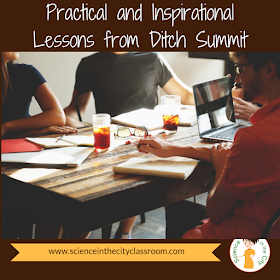What is Cue Craft Summit?
Cue Craft #DitchSummit is a free, online virtual conference for educators by educators. It was sponsored by Adobe, and featured 8 speaker videos last anywhere from 30 minutes to an hour. They're practical and inspirational, from hand-picked education leaders.

The sessions that I attended in August included:
- Solid Teaching Craftsmanship for EVERYONE - Jon Corippo and Cate Tolnai
- Emphasis on the creativity of both the teacher and students, with a priority on the educator as a learner and craftsman first. This requires a change in school culture
- Practice, Powerful, Pedagogically-charged teaching - Jennifer Gonzalez
- So much information is at our fingertips now that it is important that we teach our students to use and curate this information. We need to be smart and deliberate as we integrate technology into our classrooms. Keep track of where you are in the levels of knowledge, and what type of learning we are looking for.
- Powerful pedagogy with Hyperdocs - Kelly Hilton
- Hyperdocs change the focus to the students, and free you to work with students. Lesson design starts with thinking about your students, however, this doesn’t mean they are doing the lesson alone. This requires the careful blending of tech/no tech and thinking about the best tools and skills for students to accomplish the task.
- Dynamic Google-Infused Learning - Kasey Bell
- Technology is a tool, not a solution. You must have a purpose behind the technology, and purpose-driven professional development. There should be a focus on student learning. Dynamic refers to ways to extend the learning beyond the time and space of the classroom, and beyond traditional tools.
- The Purpose of Classroom Creativity - Ben Forta
- Focus on kids being creators, not just consumers of information and content. This can involve different definitions of creativity, as different kids have different needs.
- Powerful Learning Space Design - Rebecca Hare
- This is not a focus on the furniture but look at the surfaces and space as a place to support learning and collaboration. Less can be more. This may mean using the space on the wall for students to put up their own, making flexible learning spaces, provide students with choices.
- Helping ELL Students Succeed - Martin Cisneros
- Start with giving students the language that they need to survive, then move onto academic language. This includes a lot of non-technology ways to teach the English language, however also touches on technology as a tools that fosters collaboration and helps provide students with multiple ways to show what they know.
- Open Educational Resources - Kristina Ishmael
- Open Educational Resources are teaching and learning resources that are in the public domain and allow for their free use, modification, and redistribution. She shared multiple resources for finding these tools, and benefits. Some of the benefits include flexibility for teachers to reflect, adapt, and decide on what fits their student’s needs the best.
Main Takeaways
As I reflect on this fantastic learning experience, there are many specific tools and strategies that I can utilize, but there are some larger general messages that I want to share with you. I think in teaching we often get so focused on the day to day and the mechanics of lesson planning, that it is easy to lose track of the bigger messages.
- Individualize (both for yourself and for your students; fit the needs of those you are teaching, and your style/personality)
- Be Creative & Flexible (again both for yourself and your students)
- Continue Learning (As a professional, we are hopefully continuing to learn and grow, expand our practice, and model lifelong learning for our students)
- Focus on your students (All learning and lesson design should start with the students. Who are we teaching? What do we want them to learn? What are their interests? What do they need?)
- Emphasize learning first, and then find the tools you need (Don’t use a hands-on activity, or a technology tool just because you want to use it. These are all tools that can be implemented to reach a goal. Find the tool or strategy that will help achieve your learning goal. Or use a tool in a new way. But these are tools, not the lessons in and of themselves.
Further Resources:
Cue Craft will be having another conference in December.
Check back here for more information as it gets closer.









No comments :
Post a Comment